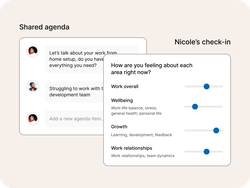
How to help managers have more impactful 1-on-1 sessions

1-on-1 meetings between managers and direct reports are becoming an increasingly popular and beneficial practice among organizations. Unfortunately, the brunt of the responsibility is being put on managers, who aren’t always given the structure, tools, or training they need to be successful. And the skills required for impactful 1-on-1’s – such as asking good questions, resolving conflicts, and guiding the growth of employees – aren’t skills that always come naturally to managers.
That’s why we encourage organizations to take a more active role in supporting managers so they can have better conversations with their direct reports. To help, we identified the most frequently asked questions around 1-on-1 meetings and shared our recommendations for each one.
The most commonly asked questions about 1-on-1’s
We took the most common questions your managers are likely to have about how to run a good 1-on-1 meeting and grouped them into three categories: value, content, and cadence. While there aren’t necessarily ‘right’ or ‘wrong’ answers to any of these questions, we provided our best responses to them below.
Value-related questions
Q. What is the purpose of a 1-on-1 meeting?
You wouldn’t hand someone a huge project without explaining why it’s important for the organization. Similarly, managers shouldn’t be expected to carry out 1-on-1 meetings without understanding why it’s an essential part of their role. 1-on-1’s can serve multiple purposes:
- Building relationships. 1-on-1’s are the only consistent, structured touchpoints that happen between a manager and a direct report. This is valuable face-to-face time that can lead to stronger relationships. 1-on-1’s are especially important now as most employees are working remotely and can’t have spontaneous check-ins or conversations with their managers.
- Supporting the development of employees. 1-on-1 sessions also provide an important growth opportunity for employees. These meetings are the time for employees to ask managers to unblock certain obstacles, work through problems, or provide resources to help them reach their goals.
- Encouraging self-reflection. 1-on-1’s carve out the time and space for self-reflection – not only for employees but for managers as well. Whether it’s discussing feedback during the meeting or reflecting on the conversation afterward, 1-on-1’s give rise to many opportunities to pause and think about how to improve oneself on a personal and professional level.
Q. What can managers do to make 1-on-1 meetings safe spaces?
Managers shouldn’t assume that employees will initially feel comfortable opening up to them during 1-on-1’s. Instead, they need to be intentional about making 1-on-1’s into a safe space. While this needs to start at an organizational level, managers can also work on building psychological safety and trust in their relationships with direct reports. Managers can accomplish this by being transparent, practicing active listening, and making it clear that the intention is always to support the employee – not fault them.
Q. What should managers prepare in advance to get the most out of their 1-on-1 meetings?
Direct reports should set and drive the agendas for 1-on-1’s to ensure they’re getting what they need from the meetings. However, managers need to be actively involved in the process as well. This means managers should contribute to the agenda or direction of the conversation, where and when it makes sense, review what the employee wants to discuss, and prepare any questions or resources that might be helpful or relevant to them.
Q. How can managers ensure their direct reports are getting value from their 1-on-1 meetings?
Below are a few tips on how to run a good 1-on-1 meeting that delivers value:
- Establish a clear goal for every meeting. Both managers and direct reports should go into every 1-on-1 with a clear sense of what they want to accomplish – whether that’s talking through a specific problem or using the time to reflect on learnings from a recent project.
- Check-in with the employee. It may sound obvious, but managers should make a point of asking employees whether they’re getting value from their 1-on-1’s. Without being prompted, direct reports may feel uncomfortable bringing up the issue themselves.
- Balance both positive and constructive feedback. It’s also important for managers to remember that 1-on-1’s should be a time for both positive and constructive feedback. While it’s nice to praise employees for their hard work, they need direction to grow and improve as well. This also gives them more opportunities to discuss and work on their personal development, which is a critical aspect of 1-on-1 meetings.
Content-related questions
Q. Who should set the agenda for the 1-on-1 meetings?
We believe in shared ownership between the manager and the direct report when it comes to 1-on-1 meetings. As we mentioned before, employees should be the ones to set and drive the agenda, but managers need to be involved in the process as well. To encourage this collaborative relationship, our platform provides a 1-on-1 space where shared agendas can be created and managed.
Q. How do you structure the agenda to make the best use of the time?
Without the right structure in place, 1-on-1’s can feel awkward or challenging to navigate. While the structure of the agenda will vary depending on what the employee needs, managers should regularly create the time and space for the following conversation topics:
- Personal updates
- Wellbeing
- Growth and career aspirations (long term and short term)
- Relationships with teammates, company leaders, etc.
- Questions or concerns
Q. What types of questions should managers ask their direct reports during 1-on-1 meetings?
Questions are an effective way to open up certain topics for discussion. A few examples of great employee 1-on-1 questions include:
- The last time we spoke you said X was a challenge for you, how is that going?
- How aligned do you feel with where the company is going?
- What has energized you in your role [over a period of time]?
- What has challenged you [over a period of time]?
- What feedback do you have for me?
- How are you progressing towards your bigger career and life goals?
To make it easier for managers, our 1-on-1 Conversations tool also has built-in questions that ask about factors impacting the whole employee experience.
Q. How much time should managers dedicate to process management vs. coaching?
Google found in its Project Oxygen study that one of the most important skills for being a good manager is coaching. That’s why we recommend having managers focus the majority of their time on coaching during 1-on-1’s. Also, since transactional status updates can easily be done via Slack or email, this limited face-to-face time should be used for more meaningful conversations.
Q. What should the balance between personal updates and business-related updates look like?
It’s all about striking the right balance and taking the employee’s preferences into account. For example, diving right into business can feel impersonal to some people. On the other hand, spending 10 minutes talking about vacation plans can be frustrating for others. So it’s important to have managers check with their direct reports to see what type of balance makes the most sense for them.
Cadence-related questions
Q. How frequently should managers have 1-on-1 meetings with direct reports?
This answer also depends on the goals and preferences of the employee. Some people may want weekly check-ins and receive as much support as possible. Others may prefer to work more independently and want a monthly 1-on-1 cadence. Either way, managers and their direct reports should feel free to experiment with cadence and find one that works for their relationship!
Q. Is it ever okay for managers to cancel scheduled 1-on-1 meetings?
It may be tempting for managers to cancel the occasional 1-on-1 when they’re busy with other projects and responsibilities. However, this should be avoided whenever possible. Even if it’s not the manager’s intention, dropping a 1-on-1 from the calendar may make employees feel like they’re not a priority, which can lead to feelings of demotivation and resentment. If it feels like there’s nothing significant to discuss during the meeting, it may be a signal that the cadence or content of the meetings needs to be revisited.
Q. What is the best way for managers to refresh themselves on what they discussed with direct reports in between meetings?
It’s natural for managers to forget the details of what was discussed during 1-on-1 meetings – especially if they have multiple people reporting to them. That’s why documenting the content of the meetings, and reviewing them after, is so critical. Managers can decide with their direct reports who should take notes and when, but it’s important to make sure there’s a system in place.
1-on-1 sessions can be an invaluable tool for your managers once they’re given the guidance to run them in an impactful way. Use the questions and answers we shared in this post to inform the resources you pass along to your managers. This can take the form of an official training session, a comprehensive guide, or anything else your managers will find useful.





